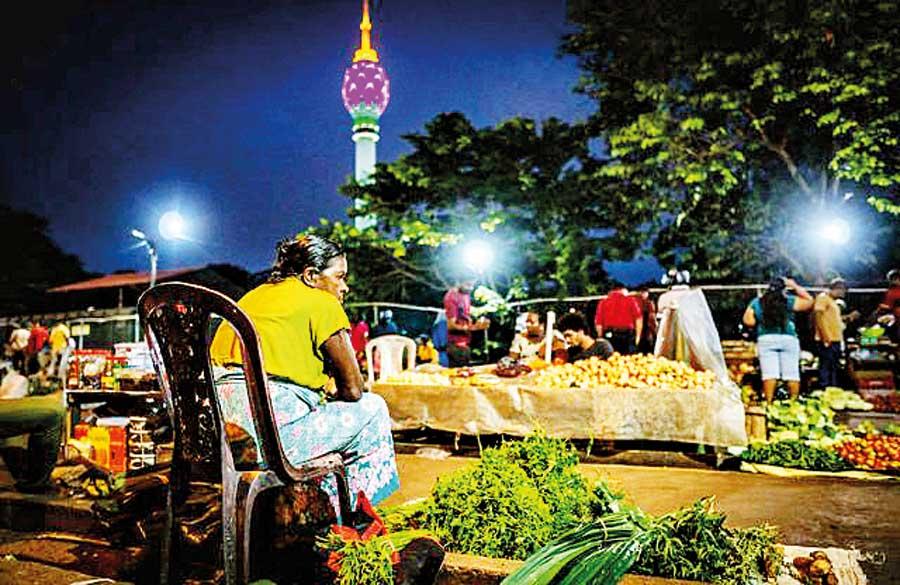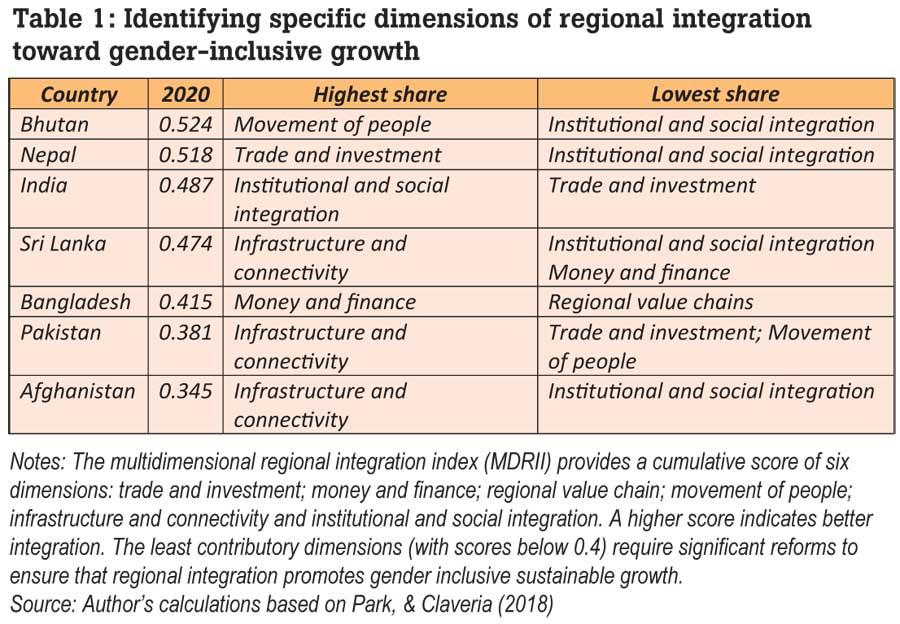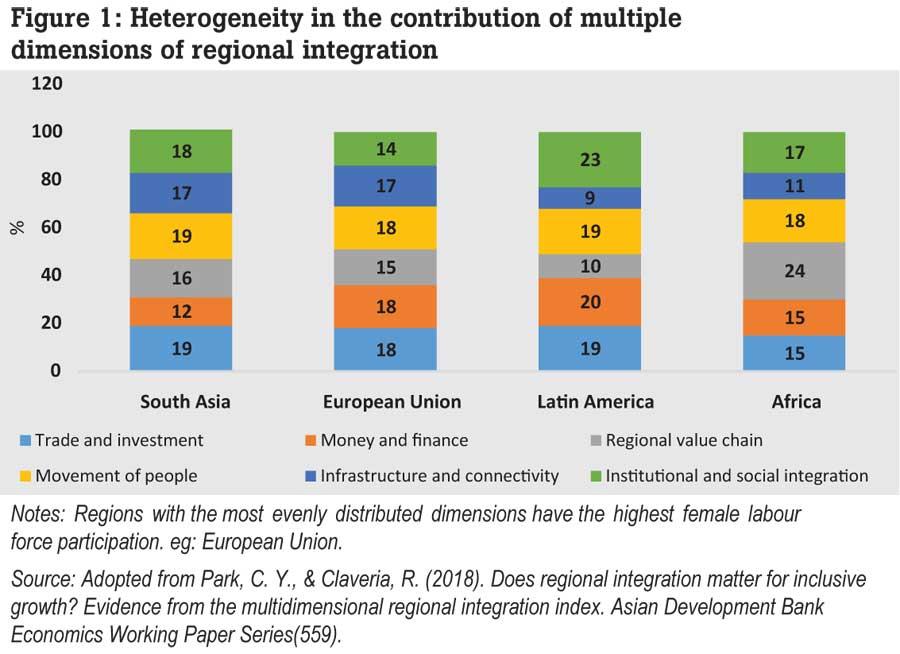10 Apr 2024 - {{hitsCtrl.values.hits}}

- On average, women are paid approximately 20% less than men in Sri Lanka
- South Asia will take 149 years to achieve full gender parity, while this is 67 and 95 years for Europe and North America, respectively
- Providing equal employment opportunities for men and women can enable South Asia to enhance incomes by 25%
- An IPS study highlights the limited success of regional integration in stimulating growth and reducing gender inequality in South Asia and offers a set of recommendations for more gender-sensitive policy reforms across sectors
Inequality results in adverse economic, social and political consequences. Unlike the advanced economies, improvements in education, fertility and incomes have not been able to enhance women’s labour force participation in Sri Lanka.
enhance women’s labour force participation in Sri Lanka.
Gender equality is a shared vision for social justice. Thus, addressing gender inequality is crucial to achieve stronger and more sustainable development. While regional integration is seen as a potential development strategy to promote inclusive and sustainable growth and efforts toward women’s economic empowerment, gender equality tends to be sidelined in such discussions.
Thus, identifying and implementing the right policy mix for meaningful regional integration is vital in creating gender inclusive sustainable growth.
Impact of greater economic opportunities for women
Greater economic opportunities for women create a domino effect. In South Asia, equal employment opportunities for men and women are estimated to enhance incomes by 25 percent, including increased intraregional trade of US $ 44 billion. Yet, despite the improvements in education and health outcomes, low women’s economic participation remains a critical development challenge for developing economies, including South Asia.
In 2021, female labour force participation was 22 percent and 32 percent for South Asia and Sri Lanka, respectively, while all other regions, except the Middle East and North Africa (18 percent) recorded more than 50 percent participation. Also, a gender wage gap of 24 percent indicates that on average, women are paid approximately 20 percent less than men in Sri Lanka. To achieve gender parity, South Asia will take 149 years, while this is 67 and 95 years for Europe and North America, respectively.
Regional integration: Current challenges and opportunities
Unlike South Asia, other regions like East Asia, Europe and North America are harnessing the potential benefits of regional integration by developing strong relationships with their neighbours. Intraregional trade accounts for 50 percent of total trade in East Asia and 22 percent in Sub-Saharan Africa but only 5 percent in South Asia. Intraregional trade as a share of regional gross domestic product (GDP) is only one percent in South Asia while it is 2.6 percent and 11 percent in Sub-Saharan Africa and East Asia and the Pacific, respectively.
South Asian regional integration has been restricted mainly by high tariff and non-tariff measures, lack of trust and political will, weak policy implementation and poor infrastructure. Although the impacts are asymmetric, deeper regional integration benefits any country.
Consumers gain access to cheaper goods and services; producers and exporters gain access to inputs, investment and production networks and firms gain market access for goods and services.

Reforming stagnating dimensions of regional integration toward gender inclusive growth
To promote gender-inclusive growth, a recent Institute of Policy Studies (IPS) study shows that it is essential to improve the stagnating dimensions of regional integration. This process is complex and varies by country, due to its multidimensional nature.
There are six key dimensions: trade and investment, movement of capital, regional value chains, infrastructure and connectivity, people’s mobility and legal and institutional basis for international policy cooperation.
Evenly distributed dimensions lead to better regional integration and higher women’s economic participation. With the most evenly distributed dimensions, the European Union is recognised as the most advanced and consistent in regional integration (Figure 1) with more than 50 percent women’s economic participation.
In contrast, South Asia’s significantly uneven dimensional distribution makes it one of the least integrated and lowest women’s economic participating regions in the world. South Asia focuses more on infrastructure and connectivity and movement of people and less on money and finance. Similarly, Sri Lanka’s regional integration is impacted heavily by infrastructure and connectivity and this is no surprise as nearly 60 percent of public investment has been allocated to infrastructure development in the last few decades (Table 1).
The IPS study further reveals that improvements to institutional and social integration and money and finance reduce nearly 50 percent of gender inequality in South Asia. Furthermore, better institutional and social integration and movement of people positively impact women in industry and services sectors but not agriculture.
In developing countries, women often engage in labour-intensive sectors, which are low-skilled and low-paid, referred to as the ‘feminisation of labour’. Regional integration creates new employment opportunities in the manufacturing and services sectors. This results in technology-led ‘defeminisation of labour’ leading to increased demand for female labour and higher wages.
In contrast, trade and integration negatively impact women in agriculture. The reason is their limited skills and mobility. Regional integration alters the structure of production where sectors with export opportunities may expand, while import substitution sectors may contract. Women in the contracting sectors may face job losses. Even in expanding sectors, women may not have benefitted due to horizontal and vertical gender segregation. Thus, selective opening of sectors and providing opportunities for upskilling and reskilling of women will help minimise the negative impacts.

Way forward
Sri Lanka is yet to receive the full benefits of regional integration. Inherently, regional integration is multidimensional and its impacts are country-specific. In boosting gender inclusive sustainable growth, a balanced contribution of different dimensions of regional integration is required. Improvements to most stagnating dimensions like institutional and social integration and money and finance would reduce gender inequality by nearly 50 percent.
Thus, robust domestic policies that support the establishment of quality institutions and governance systems and financial conduct are most effective in making regional integration a strategy that stimulates inclusive growth and women’s economic empowerment in Sri Lanka.
“The World Bank South Asia Gender Innovation Lab’s (SAR GIL) Women’s Economic Empowerment in South Asia Community of Practice provided support for this research.”
(Dr. Lakmini Fernando is a Research Fellow at the IPS, with primary research interests in development economics, public finance and climate change. She has expertise in econometric data analysis, research design and causal methodologies. Dr. Fernando holds a BSc in Agriculture from the University of Peradeniya, a Master of Development Economics (Advanced) from the University of Queensland, Australia and a PhD in Economics from the University of Adelaide, Australia.
Sulochana Silva is a Research Assistant at the IPS. She holds a BSc (Hons) in Agricultural Technology and Management, specialising in Applied Economics and Business Management from the University of Peradeniya. Her research interests are agriculture policies and institutions, environment and natural resource policies, food security and climate change)
29 Nov 2024 42 minute ago
29 Nov 2024 50 minute ago
29 Nov 2024 54 minute ago
29 Nov 2024 1 hours ago
29 Nov 2024 2 hours ago